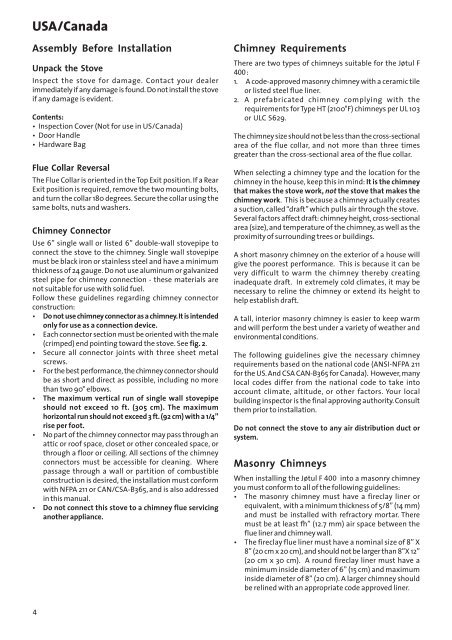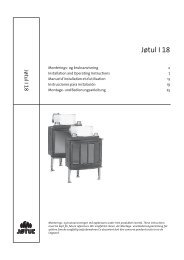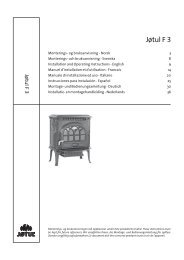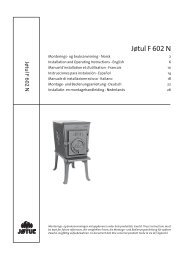You also want an ePaper? Increase the reach of your titles
YUMPU automatically turns print PDFs into web optimized ePapers that Google loves.
USA/CanadaAssembly Before InstallationUnpack the StoveInspect the stove for damage. Contact your dealerimmediately if any damage is found. Do not install the stoveif any damage is evident.Contents:• Inspection Cover (Not for use in US/Canada)• Door Handle• Hardware BagFlue Collar ReversalThe Flue Collar is oriented in the Top Exit position. If a RearExit position is required, remove the two mounting bolts,and turn the collar 180 degrees. Secure the collar using thesame bolts, nuts and washers.Chimney ConnectorUse 6” single wall or listed 6” double-wall stovepipe toconnect the stove to the chimney. Single wall stovepipemust be black iron or stainless steel and have a minimumthickness of 24 gauge. Do not use aluminum or galvanizedsteel pipe for chimney connection - these materials arenot suitable for use with solid fuel.Follow these guidelines regarding chimney connectorconstruction:• Do not use chimney connector as a chimney. It is intendedonly for use as a connection device.• Each connector section must be oriented with the male(crimped) end pointing toward the stove. See fig. 2.• Secure all connector joints with three sheet metalscrews.• For the best performance, the chimney connector shouldbe as short and direct as possible, including no morethan two 90° elbows.• The maximum vertical run of single wall stovepipeshould not exceed 10 ft. (305 cm). The maximumhorizontal run should not exceed 3 ft. (92 cm) with a 1/4”rise per foot.• No part of the chimney connector may pass through anattic or roof space, closet or other concealed space, orthrough a floor or ceiling. All sections of the chimneyconnectors must be accessible for cleaning. Wherepassage through a wall or partition of combustibleconstruction is desired, the installation must conformwith NFPA 211 or CAN/CSA-B365, and is also addressedin this manual.• Do not connect this stove to a chimney flue servicinganother appliance.Chimney RequirementsThere are two types of chimneys suitable for the Jøtul <strong>F400</strong> :1. A code-approved masonry chimney with a ceramic tileor listed steel flue liner.2. A prefabricated chimney complying with therequirements for Type HT (2100°F) chimneys per UL 103or ULC S629.The chimney size should not be less than the cross-sectionalarea of the flue collar, and not more than three timesgreater than the cross-sectional area of the flue collar.When selecting a chimney type and the location for thechimney in the house, keep this in mind: It is the chimneythat makes the stove work, not the stove that makes thechimney work. This is because a chimney actually createsa suction, called “draft” which pulls air through the stove.Several factors affect draft: chimney height, cross-sectionalarea (size), and temperature of the chimney, as well as theproximity of surrounding trees or buildings.A short masonry chimney on the exterior of a house willgive the poorest performance. This is because it can bevery difficult to warm the chimney thereby creatinginadequate draft. In extremely cold climates, it may benecessary to reline the chimney or extend its height tohelp establish draft.A tall, interior masonry chimney is easier to keep warmand will perform the best under a variety of weather andenvironmental conditions.The following guidelines give the necessary chimneyrequirements based on the national code (ANSI-NFPA 211for the US. And CSA CAN-B365 for Canada). However, manylocal codes differ from the national code to take intoaccount climate, altitude, or other factors. Your localbuilding inspector is the final approving authority. Consultthem prior to installation.Do not connect the stove to any air distribution duct orsystem.Masonry ChimneysWhen installing the Jøtul F 400 into a masonry chimneyyou must conform to all of the following guidelines:• The masonry chimney must have a fireclay liner orequivalent, with a minimum thickness of 5/8” (14 mm)and must be installed with refractory mortar. Theremust be at least ½” (12.7 mm) air space between theflue liner and chimney wall.• The fireclay flue liner must have a nominal size of 8” X8” (20 cm x 20 cm), and should not be larger than 8”X 12”(20 cm x 30 cm). A round fireclay liner must have aminimum inside diameter of 6” (15 cm) and maximuminside diameter of 8” (20 cm). A larger chimney shouldbe relined with an appropriate code approved liner.4






